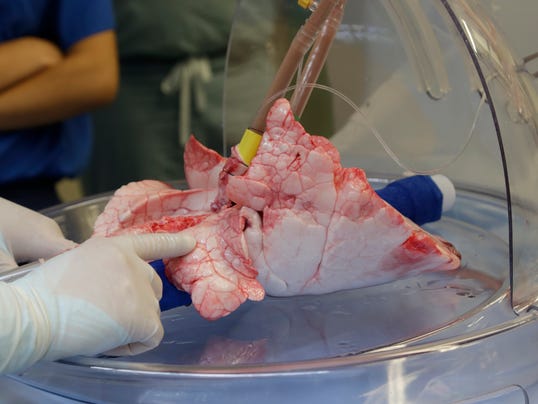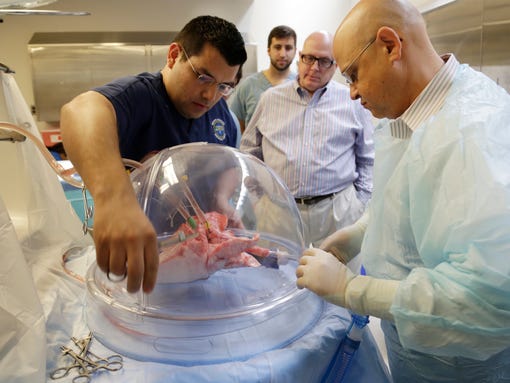
DETROIT — Creamy-pink and glistening, they lie on a stainless steel exam table — this pair of lungs inflating and falling in a rhythmic, ghostly pattern.
At the University of Michigan, researchers are pushing the limits of medicine, eking out new ways to boost the numbers of organs that are available to thousands of patients who die every year waiting for them.
That means, for a time at least, keeping human lungs — particularly delicate organs — "alive" outside the body.
"I've been in medicine for years, and I still think it's wild ... almost science fiction," said Dr. Paul Lange, medical director of Gift of Life Michigan.
It's also an unprecedented collaboration — the University of Michigan, Gift of Life Michigan and Henry Ford and Spectrum health systems — now poised to become part of a national clinical trial using a $250,000 piece of equipment purchased by Gift of Life, the organization responsible for recovering and delivering organs at eight sites around the state.
It's the kind of round-the-clock logistics work in which minutes matter.
"Outside the body, without blood and oxygen, those cells start deteriorating quickly," Lange said.

University of Michigan’s Dr. Alvaro Rojas Pena, left, and Dr. Hassan Nemeh, lung transplant director at Henry Ford, lift the cover off a set of pig lungs. In a process called ex vivo lung perfusion, the lungs are attached to a device that may help them stay alive outside the body while they await a transplant recipient.(Photo: Mandi Wright, Detroit Free Press)
With the XVIVO Perfusion System, or XPS, doctors hope to keep lungs sustained outside the body long enough to give them more time to determine whether the organs are viable for transplant. If all goes well, the lungs eventually could be kept viable for days — giving them time to heal before transplant, doctors say.
Earlier this week, the U.S. Food and Drug Administration approved the machine for use in human lungs for "humanitarian" cases — in other words, for patients for whom all other options have run out. Doctors in the clinical trial, including those in the Michigan collaborative, want the machine to be available routinely.
"So one day, could we have a warehouse of hearts being kept alive of different sizes and call up and say 'I need a heart for a 2-year-old' and the next day it comes in the mail?" said U-M's Dr. Robert Bartlett, who helped invent the technology in the 1960s on which the XPS is now based.
It seems fanciful, he acknowledges. But Bartlett remembers the days when there was little more to do for a heart attack patient after surgery than to keep the room quiet and hope for the best. He was part of the intensive care units that are now standard in most hospitals — offering new ways to keep people alive after their hearts stopped, lungs weakened and kidneys gave out.
And he helped develop, while he was in Boston, a modified heart-lung machine called extracorporeal membrane oxygenation (ECMO).
More than a traditional ventilator that forces oxygen to help a patient breathe, the ECMO also circulates a patient's blood. It has saved thousands of lives since it was developed in the 1960s and 1970s, and earlier this year, ECMO machines at U-M kept alive Michigan residents struck down by H1N1.
And Bartlett remembers, too, the days when the idea of transplanting organs from one patient to another seemed crazy.
The XPS machine — the new technology being tested here — is already being used in Canada and Europe, either as a temporary bridge to lung transplants or to evaluate the health of lungs awaiting transplant.
On this day at U-M, pinkish liquid coursed through tubes sutured to the lungs that had been cut from a laboratory pig just hours earlier and attached to the XPS, a machine that looks vaguely like a Zamboni.
It beeped. Its monitor blinked. The lungs continued to rise and fall.
This, Bartlett said, "is the extreme of life support."
Especially fragile
As it stands now, more than 123,000 Americans are awaiting new organs, according to the federal Organ Procurement and Transplantation Network.
Lungs are especially fragile. Just 20% or so of lungs among potential donors are deemed usable.
And while more than 1,900 lungs were transplanted last year across the U.S., 354 patients died on the waiting list for lungs or became too sick to receive them.
Death quickly exacts its toll on this pair of spongy organs — a person's chest has slammed into a steering wheel or fluids have thickened the walls of the lung as patients are pumped with IV fluids.
And unlike a kidney that can be put on ice and transplanted 24 hours later or more, lungs and the heart typically can be outside the body for just three or four hours, said Gift of Life's Lange.
Transplant surgeons like Michigan's Dr. William Lynch often get that middle-of-the-night "lung call" from Gift of Life.
Some of his patients, in fact, have been kept alive on the ECMO technology that Bartlett helped develop so many years ago.
If Lynch believes the lungs might work for his patient, he has just a short time to make it to the hospital where the donor lies, to slip a bronchoscope down his or her airway and into the lungs. With each moment, the ability to transplant those lungs fades.
So Lynch has a decision: Should he offer these delicate and now less-than-perfect lungs to an already weakened patient who must undergo a grueling, risky transplant? Or does he hope that a better set comes along?
Often Lynch, like other transplant surgeons, rejects the lungs because of injury or a lesion. Questions linger: Was he too cautious? Might these lungs have worked?
He knows what's at stake.
"There are so many people who can't get transplants and they die," he said.
Enter the XPS.
In addition to its ECMO-like functions, the Swedish-manufactured machine warms lungs to body temperature. Tubes, sutured into the pulmonary artery and left atrium regions of the lungs, carry a nutrient solution through the organs and allow doctors to determine whether oxygen is appropriately moving across the lung membrane.
"If I can take those lungs out for a test drive (and) spend four hours with them instead of 15 minutes, maybe we decide they really are usable," Lynch said.
In research published this month, Bartlett and his team concluded they were able to use the ECMO to improve the quality of kidneys, livers and pancreases in donors who had suffered "circulatory death" but were being kept alive by machines. In other words, the ECMO helped the body circulate oxygen-rich blood to the organs in the person who was declared dead, improving their viability before transplant.
If all goes well, the technology one day could allow doctors to remove, say, a liver full of cancer, treat it to kill the cancer and then restore it to the patient's body, says Lynch.
"What's more interesting is how long can we help them to repair?" he said.

